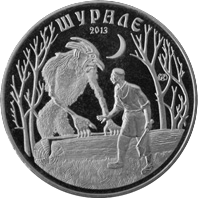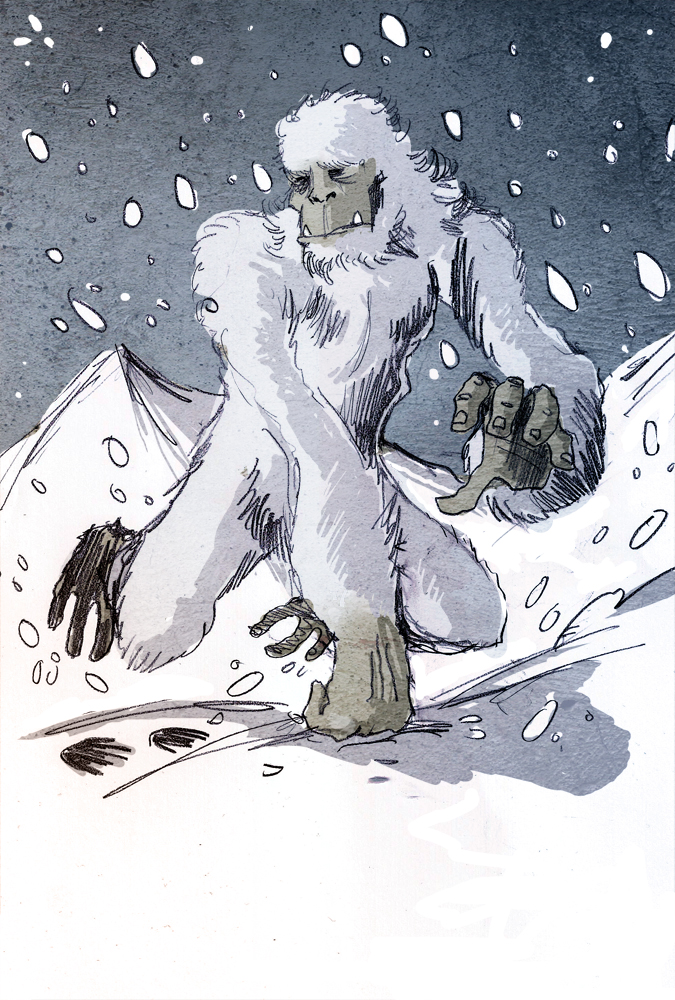|
Pitsen
Pitsen is a forest creature in the Siberian Tatars' mythology. Pitsen's role is contradictory. It could bring luck, but also troubles, leading humans to the wilderness. Shapeshifting is common for Pitsen: he may look like an elder with a staff and knapsack, but also like different animals, for example apes. Pitsen prefers to live in derelict lodges. He also likes to ride horses and to oil their mane with tar. Валеев Ф. Т., О религиозных представлениях западносибирских татар, в сб.: Природа и человек в религиозных представлениях народов Сибири и Севера, Л., 1976, с. 320-29. Pitsen, when transformed to a damsel, may have sexual intercourse or marry a human. One legend says that one hunter happened upon beautiful damsel in a forest and married her. Soon they become rich. Once he came home ahead of time and saw a tusky monster eating lizards. He cried, being horrifi ... [...More Info...] [...Related Items...] OR: [Wikipedia] [Google] [Baidu] |
Şüräle
Shurale (Tatar and Bashkir: Шүрәле, �yræˈlɘ russian: Шурале) is a forest spirit in Tatar and Bashkir mythology. According to legends, Şüräle lives in forests. He has long fingers, a horn on its forehead, and a woolly body. He lures victims to a thicket and can tickle them to death. Şüräle closely resembles other similar characters from the folklore such as Arçuri of the Chuvash, Pitsen (Picen) of the Siberian Tatars and Yarımtıq of the Ural Tatars. Description He can shapeshift into many different forms. As a human, he looks like a peasant with glowing eyes, and his shoes are on backwards. A person who befriends Şüräle can learn the secrets of magic. Farmers and shepherds would make pacts with the leshy to protect their crops and sheep. Şüräle has many tricks, including leading peasants astray, making them sick, or tickling them to death. They are also known to hide the axes of woodcutters. A person gets lost in the woods when a Şüräle cross ... [...More Info...] [...Related Items...] OR: [Wikipedia] [Google] [Baidu] |
Cyrillic
, bg, кирилица , mk, кирилица , russian: кириллица , sr, ћирилица, uk, кирилиця , fam1 = Egyptian hieroglyphs , fam2 = Proto-Sinaitic , fam3 = Phoenician , fam4 = Greek script augmented by Glagolitic , sisters = , children = Old Permic script , unicode = , iso15924 = Cyrl , iso15924 note = Cyrs (Old Church Slavonic variant) , sample = Romanian Traditional Cyrillic - Lord's Prayer text.png , caption = 1780s Romanian text (Lord's Prayer), written with the Cyrillic script The Cyrillic script ( ), Slavonic script or the Slavic script, is a writing system used for various languages across Eurasia. It is the designated national script in various Slavic, Turkic, Mongolic, Uralic, Caucasian and Iranic-speaking countries in Southeastern Europe, Eastern Europe, the Caucasus, Central Asia, North Asia, and East Asia. , around 250 million people in Eurasia use Cyrillic a ... [...More Info...] [...Related Items...] OR: [Wikipedia] [Google] [Baidu] |
Siberian Tatars
Siberian Tatars ( sty, , ), the ethnographic and ethnoterritorial group of Tatars of Western Siberia, the indigenous Turkic-speaking population of the forests and steppes of Western Siberia, originate in areas stretching from somewhat east of the Ural Mountains to the Yenisey River in Russia. The Siberian Tatars call themselves ''Yerle Qalıq'' ("older inhabitants"), to distinguish themselves from more recent Volga Tatar immigrants to the region. The word "Tatar" or "Tadar" is also used as a self-designation by some closely related Siberian ethnic groups, namely the Chulym, Khakas, Shor, Teleut, Bashkirs and Kazakhs people. The 2010 census counted more than 500,000 people in Siberia defining their ethnicity as "Tatar". About 200,000 of them are considered indigenous Siberian Tatars. However, only 6,779 of them called themselves "Siberian Tatars". It is not completely clear which part of those who called themselves "Siberian Tatars" consider themselves to be a separate ... [...More Info...] [...Related Items...] OR: [Wikipedia] [Google] [Baidu] |
Shapeshifting
In mythology, folklore and speculative fiction, shape-shifting is the ability to physically transform oneself through an inherently superhuman ability, divine intervention, demonic manipulation, Magic (paranormal), sorcery, Incantation, spells or having inherited the ability. The idea of shape-shifting is in the oldest forms of totemism and shamanism, as well as the oldest existent literature and Epic poetry, epic poems such as the ''Epic of Gilgamesh'' and the ''Iliad''. The concept remains a common literary device in modern fantasy, children's literature and popular culture. Folklore and mythology Popular shape-shifting creatures in folklore are werewolf, werewolves and vampires (mostly of European, Canadians, Canadian, and Native Americans in the United States, Native American/early American origin), Ichchadhari naag and naagin (shape-shifting cobra), ichchadhari naag and ichchadhari naagin (shape-shifting cobras) of India, the huli jing of East Asia (including the ... [...More Info...] [...Related Items...] OR: [Wikipedia] [Google] [Baidu] |
Apes
Apes (collectively Hominoidea ) are a clade of Old World simians native to sub-Saharan Africa and Southeast Asia (though they were more widespread in Africa, most of Asia, and as well as Europe in prehistory), which together with its sister group Cercopithecidae form the catarrhine clade, cladistically making them monkeys (though this is the subject of much debate). Apes do not have tails due to a mutation of the TBXT gene. In traditional and non-scientific use, the term "ape" can include tailless primates taxonomically considered Cercopithecidae (such as the Barbary ape and black ape), and is thus not equivalent to the scientific taxon Hominoidea. There are two extant branches of the superfamily Hominoidea: the gibbons, or lesser apes; and the hominids, or great apes. * The family Hylobatidae, the lesser apes, include four genera and a total of 20 species of gibbon, including the lar gibbon and the siamang, all native to Asia. They are highly arboreal and bipedal on the g ... [...More Info...] [...Related Items...] OR: [Wikipedia] [Google] [Baidu] |
Chuvash People
The Chuvash people ( , ; cv, чӑваш ; russian: чуваши ) are a Turkic ethnic group, a branch of Oghurs, native to an area stretching from the Volga-Ural region to Siberia. Most of them live in Chuvashia and the surrounding areas, although Chuvash communities may be found throughout the Russian Federation. They speak Chuvash, a unique Turkic language that diverged from other languages in the family more than a millennium ago. Etymology There is no universally accepted etymology of the word ''Chuvash'', but there are three main theories. The popular theory accepted by Chuvash people suggests that ''Chuvash'' is a Shaz-Turkic adaptation of Lir-Turkic ''Suvar'' (Sabir people), an ethnonym of people that are widely considered to be the ancestors of modern Chuvash people. Compare Lir-Turkic Chuvash: ''huran'' to Shaz-Turkic Tatar: ''qazan'' (‘cauldron’). One theory suggests that the word ''Chuvash'' may be derived from Common Turkic ''jăvaš'' ('friendly', 'pea ... [...More Info...] [...Related Items...] OR: [Wikipedia] [Google] [Baidu] |
Archura
Archura (Old Turkic: 𐰀𐰺𐰲𐰆𐰺𐰀) is a shapeshifting woodland spirit in Turkic mythology who protects wild animals and forests. Description Archura usually appears as a man, but he is able to change his size from that of a blade of grass to a very tall tree. He has hair and a beard made from living grass, and is sometimes depicted with a tail, hooves, and horns. Archura has a close bond with the gray wolf ( Turkish: Bozkurt). Legend describes him as having a red scarf and his left shoe on his right foot.Türk Mitolojisi Ansiklopedik Sözlük, Celal Beydili, Yurt Yayınevi (Page - 67) He also had no shadow. Archura protects the animals and birds in the forest and tells them when to migrate. He can shapeshift into many different forms. As a human, he looks like a peasant with glowing eyes. Archuras are terribly mischievous beings: they have horrible cries, and can imitate voices of people familiar to wanderers and lure them back to their caves, where the Archuras will ti ... [...More Info...] [...Related Items...] OR: [Wikipedia] [Google] [Baidu] |
Yeti
The Yeti ()"Yeti" ''Random House Webster's Unabridged Dictionary''. is an ape-like creature purported to inhabit the Himalayan mountain range in Asia. In western popular culture, the creature is commonly referred to as the Abominable Snowman. Many dubious articles have been offered in an attempt to prove the existence of the Yeti, including Anecdotal evidence, anecdotal visual sightings, disputed video recordings, photographs, and plaster casts of large footprints. Some of these are speculated or known to be hoaxes. Folklore studies, Folklorists trace the origin of the Yeti to a combination of factors including Sherpa people, Sherpa folklore and misidentified fauna such as Himalayan brown bear, bear or yak. The Yeti is commonly compared to Bigfoot of North America, as the two subjects often have similar physical descriptions. ...
|
Turkic Legendary Creatures
Turkic may refer to: * anything related to the country of Turkey * Turkic languages, a language family of at least thirty-five documented languages ** Turkic alphabets (other) ** Turkish language, the most widely spoken Turkic language * Turkic peoples, a collection of ethno-linguistic groups ** Turkic migration, the expansion of the Turkic tribes and Turkic languages, mainly between the 6th and 11th centuries ** Turkic mythology ** Turkic nationalism (other) ** Turkic tribal confederations See also * * Turk (other) * Turki (other) * Turkish (other) * Turkiye (other) * Turkey (other) Turkey is a country in Asia and Europe. Turkey may also refer to: Birds * Turkey (bird), the genus ''Meleagris'', including several species of large birds native to North America and Central America **Ocellated turkey, native to the Yucatán ** ... * List of Turkic dynasties and countries {{disambiguation Language and nationality ... [...More Info...] [...Related Items...] OR: [Wikipedia] [Google] [Baidu] |



.jpg)
.png)
